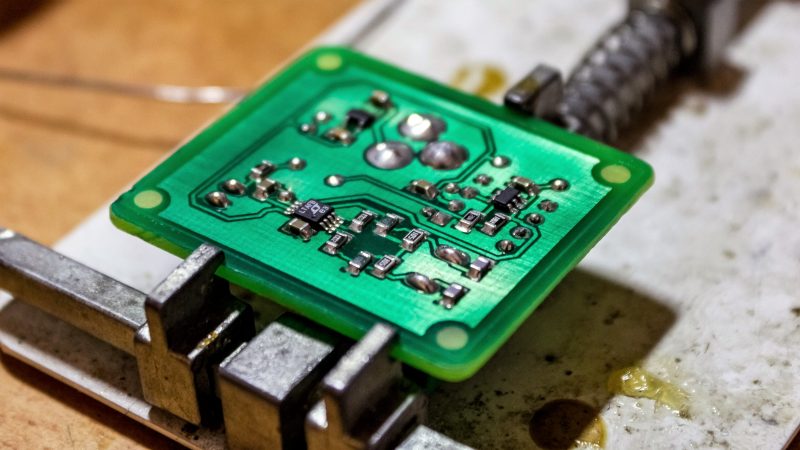When you want to measure temperature with an Arduino or other microcontrollers, there are a ton of options for sensors. Temperature chips and sensor modules abound, some with humidity sensors built-in and all with easy interfacing and an expansive supporting code library. But dip one of those sensors into, say, molten aluminum, and you’ve got a problem.
If you’re measuring something hot, you need a thermocouple. Trouble is, the signal from a thermocouple is pretty small, and needs amplification and compensation before being fed into the ADC of a typical microcontroller. Unable to find a commercial amp to meet his needs, [MonkHelios] built his own thermocouple amp for microcontrollers. The design is centered around an LTC2053 instrumentation amp, which does the job of converting the K-type thermocouple’s 40.6μV/°C output to a nicely scaled 10mV/°C range, just right for ADC consumption. He also thoughtfully included an LT1025 cold-junction compensator; thermocouple amps are referenced to 0°C, so the compensator measures the actual temperature of the cold end of the junction and scales the output accordingly. The whole amp is nicely laid out on a DIY single-sided PCB with meticulously applied solder mask — this is one of the nicest home-etched boards we’ve seen in a long time.
[Bil Herd] designed a similar thermocouple amp not too long ago himself, so you might check that out too. Or maybe you need the basics of instrumentation amps? Our “Beyond Measure” series will get you started.
















Or for $18?
https://www.adafruit.com/product/3263
Nice, but a multi-thermocouple chip I’ve used is the MAX31856, it can interface to K,J,N,R,S,T,E,B with 50/60Hz filtering and fault detection, etc, and talks SPI.
… without fun
I agree. He made one himself and not only learned from it, but most likely had fun doing it. I guess it’s the same reason a person would build their own boat. You can buy cheaper, but not have the satisfaction of doing it yourself.
or MAX6675. Hard to beat $2-3 for a breakout board with free shipping.
Yes, I stumbled onto that recently. Works like a charm, and very inexpensive.
The only thing I could say is that if you have nothing but time and money and analog design expertise, you could improve the accuracy a little bit with a custom analog design.
And the ad595, which I used today.
Still a nice project, but there are some great ic’s available for thermocouples.
They’re spendy though. I did something very similar to OP, but with a separate SPI ADC and a TMP35 going to the micro’s onboard 8 bit ADC for CJC. It took up more board space, but cost less than half as much as an AD595.
LT1761ES5 is $3.06 (AUD, Digikey, 1x)
Let’s assume you need a regulator anyway though, so it doesn’t really enter into comparative economics.
AD595AQ is $26.42. Substantially more expensive than other options.
LTC2053CMS8 is $8.64
LT1025CS8 is $7.99
LTC2050CS8 is $3.21
Using top-shelf posh silicon vendors like Linear Technology and Analog for everything is always going to give you a really high BOM cost.
I used the TI ADS1220 for thermocouples, and it worked very well. Internal programmable gain amplifier, 24 bit ADC, and SPI output. It’s basically a single chip solution. It’s not super cheap, but it is super flexible.
I would actually prefer your solution. Looks like the LTC2053 used in the project costs >7$ in single units too, so your ADS1220 solution is maybe a $ more expensive (without the cold junction compensation), but having the complete amp and high precision ADC in the same package close to the sensor-connector and digitally transmit data to your processor is a lot less error prone than having an analog signal path and protect that from any external influence on the way from the the amp to the controller.
For temperatures up to around 500C+, I use PT100 or PT1000 sensors with a MAX31865 interface. These are less sensitive to termination issues and don’t require cold junction compensation for accuracy. My main difficulty was obtaining good quality sensors at decent prices although overall they are competitive with thermocouples. I have had mixed results buying from China. Make sure you get sensors with 3 or 4 wires.
I see the arrows for thermal contact, but don’t see anything in the top photo of the final pcb, other than placement next to each other, that make me comfortable that the cold junction temperature sensor and the cold junction itself will be at the same temperature.
Those are good recommendation for someone planning to work on a simple project involving the Thermocouple. Sometimes the small voltages maybe a challenge but if you know how to work around, then it won’t be a big problem.